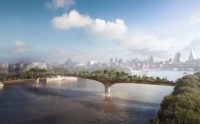Since its appointment in late spring as preferred bidder, a joint venture of Paris-based Bouygues Travaux Publics S.A. and Italy-based Cimolai S.p.A. have been developing GBT’s reference design before sealing a contract this fall. If all goes to plan, construction will start early next year and end in summer 2018.
Arup’s reference design for bidders fixes the outer geometry and appearance, freeing the contractor to amend the
internal structure, says Francis Archer, an Arup associate director. Instead of adopting Arup’s proposed radial trusses in the deck, the contractor’s design firm Flint and Neill, London, favors a box-girder spine over the concrete piers.
Whatever form the internals take, the exterior down to near the riverbed would be covered with rust-resistant material. The deck underside would comprise a 0.1-centimeter-thick skin of cupronickel roll bonded onto generally 1-cm-thick structural steel plate. Piers will be clad with 0.8 cm of solid alloy.
While the multifaceted cladding appears complicated, it will have “zero double curvature,” says Archer. Around 70% of it will be in flat plate, and the rest will curve only in one plane.
Because of the heavy, 2,000-tonne loads on each pier, the bridge foundations would resemble those of skyscrapers, says Archer, including 2.1-m-dia piles bored down some 50 m.
To minimize sitework, the JV plans to fabricate the deck in Italy in two main sections, about 110 m long and 30 m wide. The 3,500-tonne modules would be barged upriver and jacked onto the piers.
The structure will stand as two separate balance cantilevers until all the soil has been deposited. Then, crews will make final connections at midspan and abutments, making the deck continuous.
Construction needs to start next year or the contractor risks competing for logistical access to the river with the huge Thames Tideway sewer project and a large metro scheme, says Archer.
With much of the investment going into land acquisition and associated buildings, Arup estimates the cost of
the bridge alone at $155 million at today’s prices, which is 1.5 times more per sq m of deck than the nearby Millennium footbridge. But to accommodate plants, the Garden Bridge deck is more than four times as large.
Operating with a fixed budget, GBT aims to transfer maximum risk to the contractor by using a lump-sum design-build contract, says Archer. As well as taking construction risk, the contractor must deal with many stakeholders, including the port authority, he adds. “They’ll price for that.”




Post a comment to this article
Report Abusive Comment